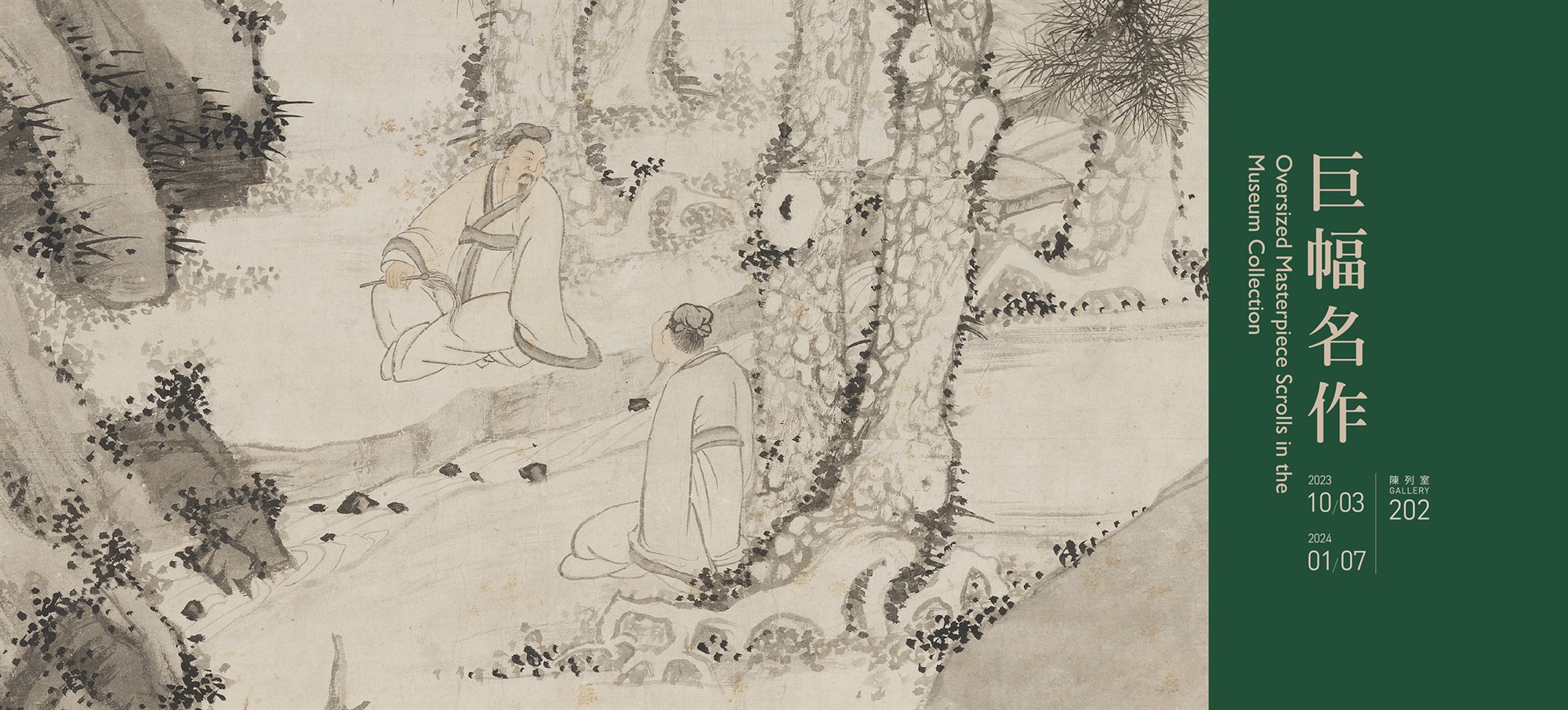Selections
-
Lofty Leisure at a Mountain Inn, Guo Xi, Song dynasty
In this mountainous scene travelers gather in an inn where an old man relaxedly strums his zither, while other sojourners cross a nearby river by boat. This painting is interspersed with vignettes of human life, bringing an atmosphere of bustling activity to a natural landscape rife with buildings, thatched huts, pavilions, and bridges. The mountains and boulders were portrayed using the “rolling cloud” texturing strokes created by Guo Xi (1023-1085) of the Northern Song dynasty, but supplemented with the “short hemp fiber” texturing strokes associated with the painters Dong Yuan and Juran. The groves of trees feature the “crab claws” method of painting tree branches, executed with a high degree of skill. Although it looks very similar to Guo Xi’s work, this painting’s scenery is too complicated and cluttered to be Guo’s. From its style and techniques, it can be inferred that this work was likely painted by Li Zai (fl. ca. early 15th century).
Li Zai, from Putian in Fujian province, had the style name Yizheng. During the Xuande reign period (1426-1435) he served as a painter-in-waiting at the Hall of Benevolence and Knowledge alongside Dai Jin and Zhou Wenjing. He studied the landscape paintings of Guoxi, Ma Yuan, and Xia Gui.
-
Hibiscus at Dawn, Ma Lin, Song dynasty
Donated to the NPM by Chang Wei-chen, wife of Luo Chiah-lun
Ma Lin (ca. 1180-after 1256) was Ma Yuan’s (f. 1190-1224) son as well as student. During the reign of Southern Song dynasty emperor Ningzong (r. 1195-1224) he served as an attendant in the imperial painting academy.
This painting depicts a waterfront veiled in fog, at the moment when hibiscus flowers first come into bloom, the moon’s reflection suspended in the water below. Regardless of whether they were painted as buds or blossoms, the hibiscus flowers are all precisely portrayed at various angles and orientations. The leaves are also quite extraordinary, each of them depicted head-on, from the side, from behind, twisted, and even dried-out or eaten by insects. Apart from their heavy outlines, the branches were all given careful washes to create a sense of volume. Much attention was also devoted to the ripples atop the water, wish washes added to the linework to effect undulating motion. The moon’s reflection is especially detailed, such that even the lunar craters were included. This painting uses mist in a manner that brings spatial depth and layering to the waterside hibiscus plant. With attentiveness and meticulousness, Ma bestowed later generations with a large-scale floral painting of superlative quality.
-
Gazing at a Waterfall from Beneath the Pines, Wen Zhengming, Ming dynasty
Wen Zhengming (1470-1559) was from Changzhou in Jiangsu province. Although his name was Bi, he later used his style name, Zhengming, in place of his given name. Wen had the sobriquets Tingyunsheng (“Stopping Clouds”) and Henshang Jushi (“Recluse from Mt. Heng”).
In a forest of pine trees, clear water from a mountain spring flows along a winding course. Two scholars beneath the pines fix their undivided attention upon the water flowing from this sylvan spring, creating a scene of pristineness and leisure. Wen mostly painted works that were delicate and lustrously pretty. This painting, however, is not only especially large in scale, but also marked by bold, unrestrained brushwork. The work, which possesses an energy that is very much out of the ordinary, is a rare example of a large format masterpiece by Wen Zhengming.
-
Calligraphy of Ten Paternal Instructions in Coupled Phrases, Wen Zhengming, Ming dynasty
Wen Zhengming (1470-1559), a native of Changzhou in Jiangsu province, had the given name Bi, but he was known by his style name, Zhengming. He also had the style name Zhengzhong, as well as the sobriquets Tingyunsheng and Henshang Jushi (“Stopping Clouds” and “Recluse from Mt. Heng”, respectively). Excelled in the arts of poetry, prose, calligraphy, and painting, he is remembered as one of the four masters of the Ming dynasty.
This scroll was written when Wen was seventy-two years old in response to a friend’s entreaties. A transcription of the ten precepts taught to children in his friend’s family, it was intended to hang to the right of his friend’s seat in the home. Although Wen Zhengming wrote this piece at an advanced age, there are no signs of languor—quite the opposite, the entire work was written with vigorous brushwork in one fell swoop.


